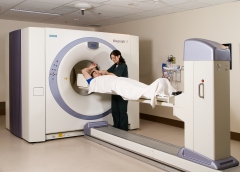BrainCare Part II: World-Class Expertise and Technology
January 30, 2014
Without embellishment, BrainCare has managed to create a brain tumour diagnosis/surgery/treatment paradigm that I believe is unique in the world. Perhaps this is simply due to the luck of timing, but as they say, the harder you work, the luckier you get.
There are three foundations:
Firstly, the BC Cancer Agency has a world-class Functional Imaging Program. Under the supervision of Dr. Don Wilson and Dr. François Bénard, we now have the capacity to see the metabolic activity of a malignant brain tumour using PET CT. The standard methods to image a tumour consist of CT and MRI. But these are static anatomic pictures of a heterogeneous, biologic entity. Methionine-PET CT greatly improves our ability to target the worst parts of a brain malignancy.
Secondly, at the Vancouver General Hospital, in collaboration with the BC Cancer Agency, we will (finally) launch our Neuroblate, a laser device that uses MR image-guidance to kill tumour cells in a minimally invasive surgical procedure. The VGH operating room also has the unique capacity to integrate PET CT into the actual intra-operative surgical removal of a tumour using sophisticated neuronavigation technology. Brain tumour specimens removed at VGH undergo a process by which they are ‘banked’. Portions of the tumour are snap-frozen, which preserves many crucial receptors, molecules and chromosomes for further analysis. We hope to extend this ‘tumour banking’ to all other neurosurgical centres in the province.
Finally, the BC Cancer Agency’s Genome Science Centre, guided by Dr. Marco Marra and the Agency’s Centre for Translational and Applied Genomics, guided by Dr. David Huntsman and Dr. Stephen Yip (a VGH neuropathologist and BrainCare brain tumour researcher), are working with Functional Imaging and the VGH tumour bank to create a standardized process by which all tumour samples will undergo genetic sequencing. This concept has been described by other bloggers on this site, but what it means for brain cancer patients is that their individual tumour will be analyzed for specific abnormalities which make it unique from all other tumours, despite being in the same class of malignancy. This allows us to tailor a specific treatment for that specific tumour, as opposed to a cookbook of treatments based on ‘what works for most people’: true personalized cancer care.
So yes, we can imagine the day soon where, right here in B.C., we can tell an individual that after exhaustive testing we have found very specific abnormalities in their tumour that are different from any other tumour. Based on that constellation of abnormalities, we will be able to prescribe a very specific combination of treatments – not a standard regimen given to everyone, but a unique combination based on in-depth knowledge of their tumour. Once again, information becomes our best tool.
I don’t know how many of us still cling to the idea that the ‘cure’ for cancer comes from a scientist working madly on that one wonder drug that will fix everything, and if we just wait for the one miraculous discovery, then everyone will get that drug (when it gets approved) and everyone will be cured. It’s not going to be that way. That way hasn’t worked. But you can see that this is not my vision, and I hope the vision of the BrainCare team makes sense to you.
There is a common theme to all the elements of our research direction—functional imaging, the Neuroblate, neuronavigation, the Brain Tumour Bank and the genomics project—and that has been the BC Cancer Foundation. I can unabashedly and transparently say that each and every one of these initiatives has been supported, if not created, by the strength and faith of BC Cancer Foundation donors. BrainCare isn’t here without the unfailing support of individuals all across B.C. who give to the BC Cancer Foundation.
Brian

State-of-the-Art Scanning Technology a First for Canada
Support BC Cancer – Vancouver’s Technology Transformation — a suite of best-in-class diagnostic, imaging and radiation equipment, including the Next Gen PET/CT.
Donate Today
